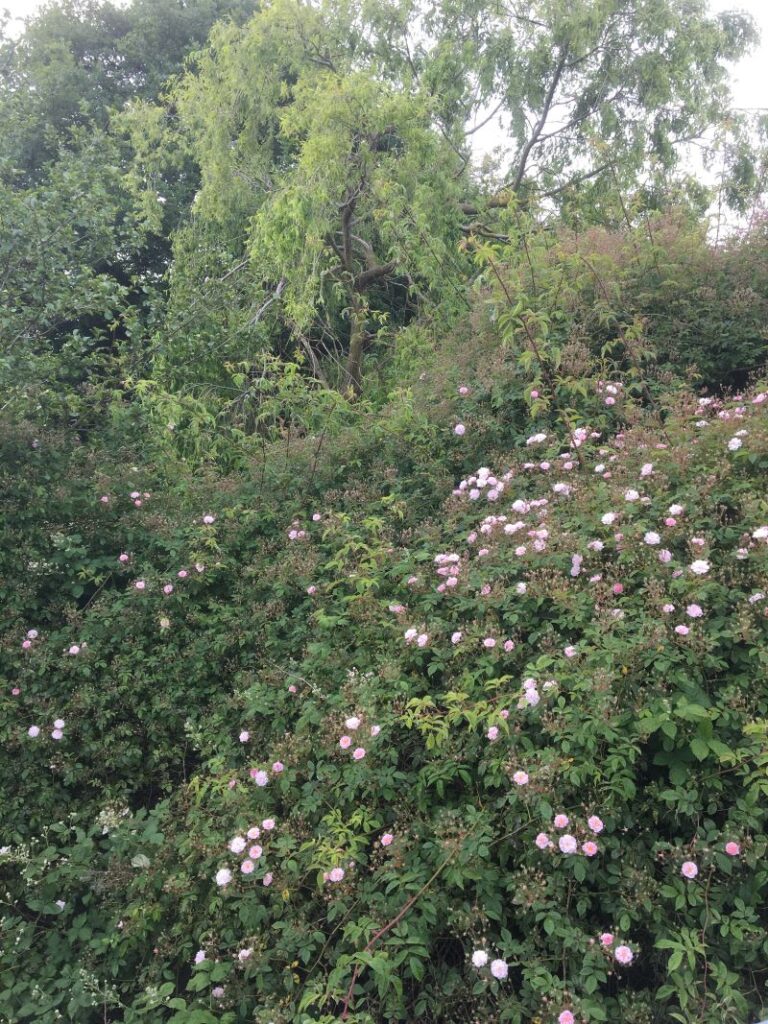‘The Rose looks fair, but fairer we it deem
For that sweet odour which doth in it live.’
Sonnet 54
Shakespeare’s rose garden; an Elizabethan stage full of roses. This great playwright and poet uses the rose more than any other flower to illustrate his language and convey his meaning. How many times he refers to a specific variety of rose or roses in general I do not know. Depending on who you believe, it’s somewhere between 50 and over 70! Some even suggest 100. I do know, however, that he relies on the rose many times to make his point and each mention is a joy to read. It seems he appreciated roses, their charm and fragrance and we can imagine a beautiful rose garden through his writing.
Roses were grown in the Elizabethan gardens not only for their beauty and fragrance but also for their medicinal, culinary and cosmetic uses. Many of the larger houses would have a Still Room where roses would be used with other plants to create fragrant items such as perfumed bags (sweete bags), potpourri, pomanders, rose water and incense burners. These would mask the odours of poor sanitation. A myriad of medicinal remedies to cure the minor ailments of everyday life would also be made by the diligent housewife and her servants.
Blooming in Shakespeare’s garden are several species roses and hybrids including: the Musk Rose – R moschata, the Damask Rose – R damascena, R. alba, R. gallica, R. gallica versicolor (Rosa Mundi), the Provencal rose, the Eglantine Rose or sweet briar – R. rubinigosa and the Wild Dog Rose – R. canina. It is likely that a collection of rose varieties also flourish but of course rose varieties in Shakespeare’s lifetime were not as numerous as they are today but were fewer and wilder in habit and growth but no less beautiful and fragrant. (These are grouped as species and hybrids here as it is not clear which are species and which are hybrids). Throughout this story the roses are referred to by their common names as they were known by the majority of people in the days of Shakespeare.
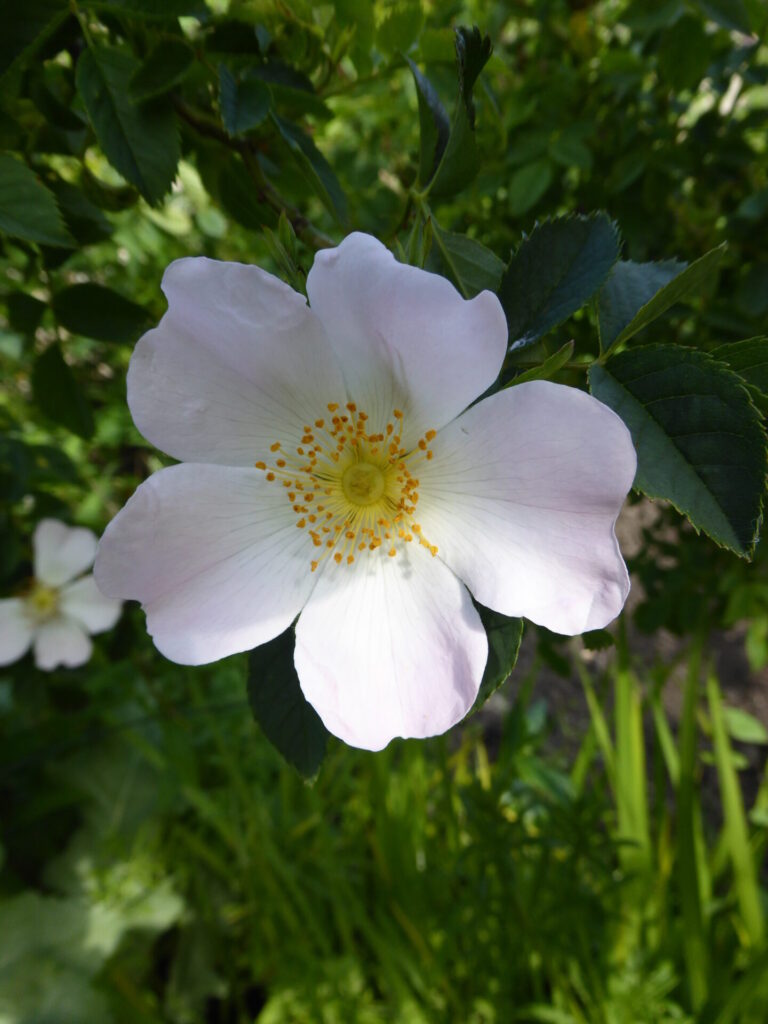

Shakespeare refers to “Cakes of roses” as part of the stock-in-trade of the Apothecary in Romeo and Juliet and “Rosewater” in the prologue of ‘The Taming of the Shrew’. The Gallica Rose, one of the most ancient of roses, was a favourite for drying and using as a source of fragrance. Although Shakespeare does not mention the Gallica Rose by name it is likely to be the ‘red rose’ in his writings. The Musk rose was also favoured for its perfume as it was the rose with immense clusters of blooms which perfumed the air and chosen by Shakespeare to adorn Titania’s bower.
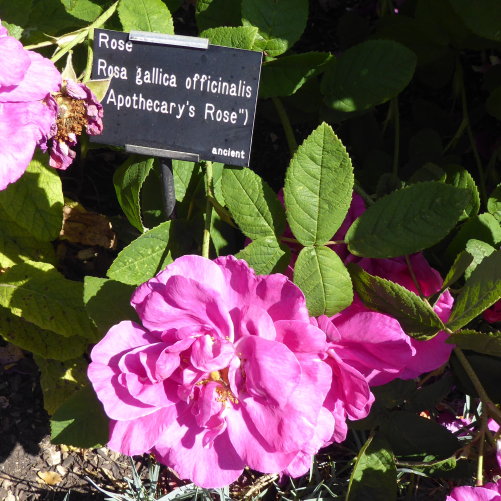
From war to romance; whatever Shakespeare’s subject he liked to enhance his meaning with roses, their beauty and particularly their fragrance. His knowledge of roses illustrates his poetic lines with the symbolism and imagery which allow us to picture the beautiful rose blooms in his garden.
The Gallica and Alba roses come into their own in the conflict between the houses of York and Lancaster in Henry VI parts one and two. Before the Wars of the Roses Shakespeare refers to the intention of the Duke of York to ‘grapple with’ the House of Lancaster.
‘Till Henry, surfeiting in joys of love
With his new bride and England’s dear bought queen,
And Humphrey with the peers be fall’n at jars;
Then I will raise aloft the milk-white rose,
With whose sweet smell the air shall be perfum’d
And in my standard bear the arms of York,
To grapple with the House of Lancaster,
And force perforce I’ll make him yield the crown,
Whose bookish rule has pull’d fair England down.’
Henry VI Part 2 Act 1 Scene 1.
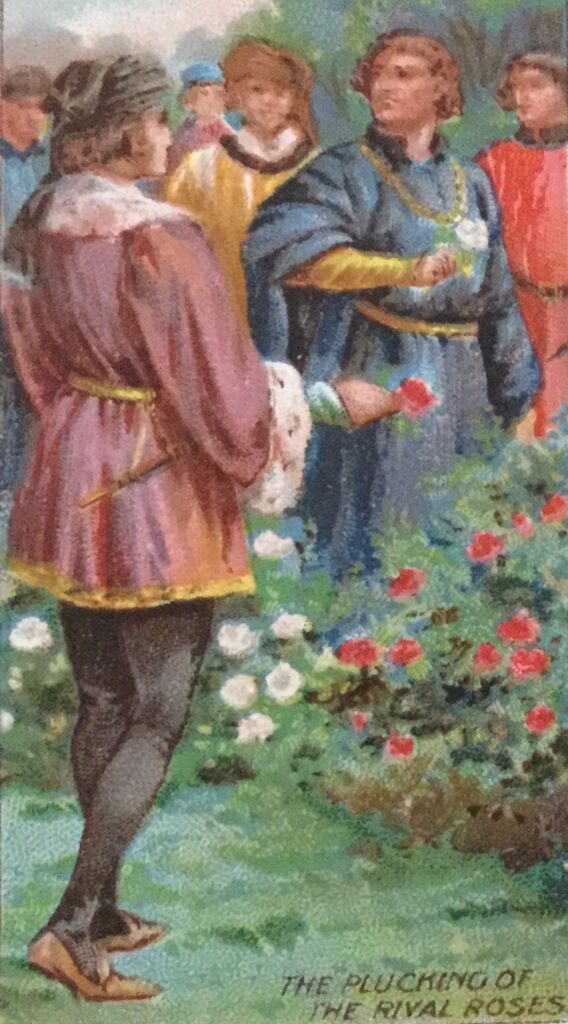
In reality, the power struggle ignited around financial and social troubles after the 100 Years War, which, combined with the mental infirmity and weak rule of Henry VI, revived interest in Richard, the Duke of York’s claim to the throne. The Wars of the Roses were ignited, a constant battleground between the Houses of York, with an emblem of a white rose and Lancaster, with an emblem of a red rose.
Shakespeare creates a scene in Henry VI Part 1 where the opposing parties choose sides, represented by the red or white rose, before the battles begin:
Plantagenet
‘Let him that is a true born gentleman
And stands upon the honour of his birth
If he suppose that I have pleaded truth
From of this briar pluck a white rose.’
Somerset
Let him that is no coward and no flatterer,
But dare maintain the party of the truth,
Pluck a red rose off the thorn with me.
Henry VI Part 1 Act 2 Scene 4
Years and many battles later, culminating in the Battle of Bosworth, the victor Henry VII, after taking the throne, married Elizabeth of York, the eldest daughter and heir of Edward IV thereby uniting the two claims to the throne and bringing the roses together. The Tudor rose was formed, where the red rose surrounds the white. The rose has been the national emblem of England since that time.
Shakespeare gave Henry this final speech:
We will unite the white rose and the red:
Smile Heaven upon the fair conjunction
That long hath frown’d upon their enmity.’
The House of Tudor ruled England until 1603, with the death of Elizabeth I, granddaughter of Henry VII and Elizabeth of York.
The white rose of York whether that of reality or Shakespeare is thought to be the Alba rose or Dog Rose and the red rose of Lancaster is more certainly the Gallica Rose. The Alba Roses are a very old group and native to the western hemisphere. It is thought they were brought to Britain by the Romans and were used not only for their beauty and fragrance but also their medicinal properties. They can also be seen in paintings from the Middle Ages onwards. It is generally agreed that they are a result of natural hybridisation between the Damask Rose and the Dog Rose. The Alba rose grows taller than the other old roses and was formerly known as the Tree Rose.
The Dog Rose is a native of Europe. It is likely that Shakespeare would have grown these roses in the hedgerows surrounding the garden rather than in the garden itself as the Dog Rose is a very pale five petalled rose with little to offer other than its delicate fragrance.
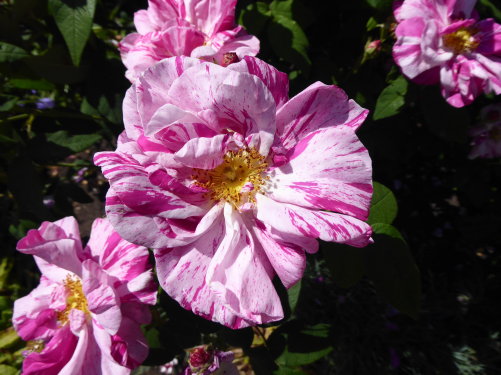
Shakespeare does not mention the York and Lancaster rose by name but this could be the variegated Gallica versicolor or Rosa mundi with its striped petals which has been known for centuries. It could also be the Damask versicolor rose which is not striped but has the occasional red petal amongst its white ones. He refers to this rose several times notably in Sonnet XCIX:
‘The roses fearfully on thorns did stand,
One blushing shame, another white despair,
A third, nor red nor white, has stol’n of both
And to his robbery had annexed thy breath.’
And Sonnet CXXX which gives weight to the Damask rose:
‘I have seen roses damask’d, red and white,
But no such roses see I in her cheeks.’
Turning to romance the story of Romeo and Juliet contains probably the most famous of Shakespeare’s references to roses. He relies on the fragrance of the rose to allow Juliet to explain to herself that she and Romeo can solve the problem of their opposing families. Sadly he does not name the rose but knows they are all fragrant and beautiful . . . . .
Juliet
‘Tis thy name that is my enemy;
Thou art thyself, though not a Montague.
What’s Montague It is nor hand, nor foot,
Nor arm, nor face, nor any other part
Belonging to a man. O, be some other name!
What’s in a name? That which we call a rose
By any other name would smell as sweet;
So Romeo would, were he not Romeo call’d,
Retain that dear perfection which he owes
Without that title. Romeo, doff thy name,
And for that name which is no part of thee
Take all myself.’
Shakespeare could have been referring to any of his fragrant roses here but in A Midsummer Night’s Dream he is more specific. When Oberon is looking for Titania so he can ‘streak her eyes’ with the juice from a flower that will make her fall in love with the first person she sees, he says to Puck
‘I know a bank where the wild thyme blows,
Where oxlips and the nodding violet grows,
Quite over-canopied with luscious woodbine,
With sweet musk-roses and with eglantine;
There sleeps Titania sometimes of the night,
Lull’d in these flowers with dances and delight;’
And when Titania wakes and falls in love with Bottom, who has been given an ass’s head by Puck, she says to him:
‘Come sit down upon this flowery bed,
Why I thy amiable cheeks do coy
And stick musk-roses in thy sleek smooth head
And kiss thy fair large ears, my gentle joy.’
The Musk rose is a native of Southern Europe and North Africa but the Musk Rose of Shakespeare is likely to have been R.arvensis, a native of Britain and Europe. It still grows in many of our copses and hedgerows and flowers later than the Dog Rose. It has creamy white wide-open flowers and yellow stamens and is very fragrant. It is also possibly the ‘milk white rose’ found in Henry VI. The Musk Rose is very definitely more pink than creamy white and was only brought into the country in the reign of Elizabeth 1st.
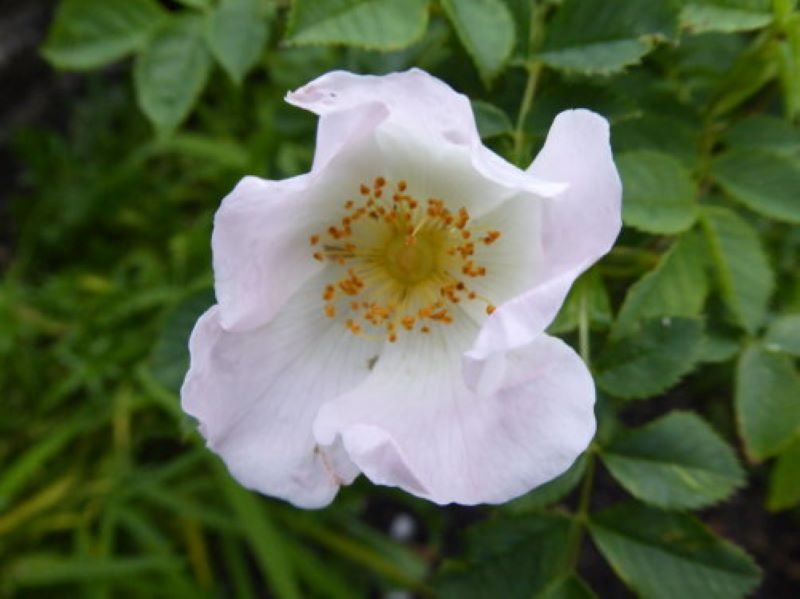
Eglantine is commonly called the Sweet Briar but was known as Eglantine in the days of Shakespeare. It is a beautiful wild, five petalled rose which is a delicate pink with a strong apple like fragrance. Whether in the hedgerows or the garden I am sure that Shakespeare appreciated these fragrant roses.
The Winters Tale, can be regarded as a comedy or romance and is a complicated play where Shakespeare chooses more roses from his Elizabethan rose garden. They are included in Act 4 Scene 4. Towards the end of the scene Autolycus enters singing:
Lawn as white as driven snow;
Cyprus black as e’er the crow;
Gloves as sweet as Damask roses.
He could not have a rose garden without a Damask Rose, which like the Gallica Rose dates back to ancient times. It is said to have been widely grown by the Persians and brought to Europe by the Crusaders. The Damasks are usually very fragrant and have been used to make rose oil for many centuries. It is known, also, that dried rose petals were often kept with gloves to keep them fragrant.
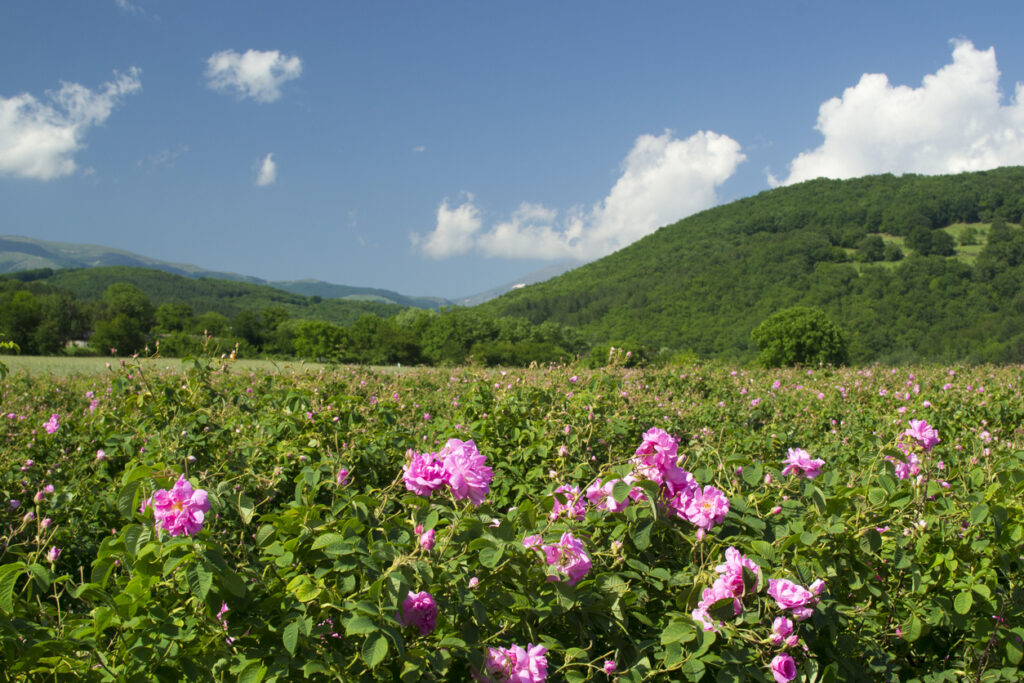
This mention of the Winter’s Tale is also likely to refer to a rose because roses have been propagated like this for many years and for a serious rose gardener the knowledge of propagation is essential:
You see, sweet maid, we marry
A gentler scion to the wildest stock,
And make conceive a bark of baser kind
By bud or nobler race: this is art
Which does mend nature, change it rather, but
The art itself is nature.
The main groups of old roses found in England before the introduction of roses from China, are all included in Shakespeare’s garden apart from Centifolias and Moss. These roses did not appear until the end of the 16th century and this was in Holland where they were being developed. The Gallicas, the Albas and the Damasks, together with several of the native species roses flower abundantly and freely in Shakespeare’s poetry and plays and enhances them with their beauty and fragrance. There are further references to ‘blown roses’ ‘damask’d roses’, ‘buds’ ‘thorns’ and so on in a number of his sonnets and plays but we can already imagine both the beauty and fragrance of that Elizabethan garden.
